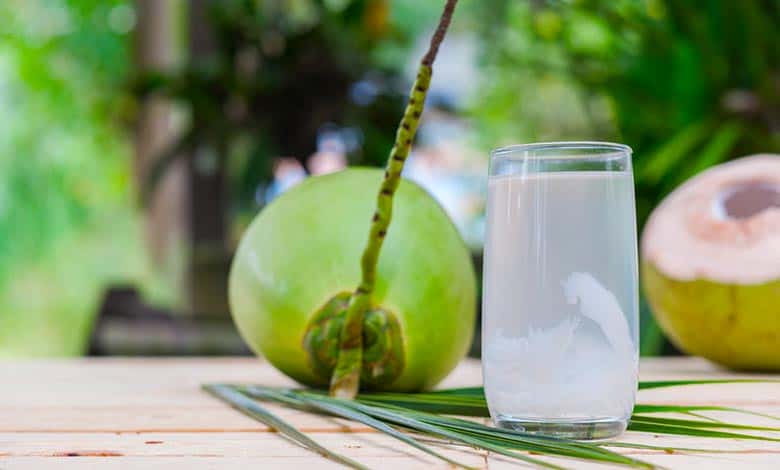
Coconut water is natural water that has fat-free water. It has high-reach electrolytes and vitamins. It also has minerals like sodium, magnesium, calcium, iron, protein, and phenolic compounds. The raw coconut water consists of vitamin B complex, some amino acids, and living enzymes, which will allow for the digesting and metabolic activity in the human body. Do you know how water exists inside a coconut? Let’s learn about it.
How Does Water Get Into Coconut? (Water Creation Process)
Water enters coconuts through “coconut water” or “coconut juice” formation. Here’s how it happens:
Development of the Coconut: Coconuts are the fruit of the coconut palm tree (Cocos nucifera). As the coconut develops, it goes through several stages.
Endosperm Formation: The inner part of the coconut, known as the endosperm, is initially a liquid called “coconut water” or “coconut juice.” The endosperm is the nutrient-rich tissue that nourishes the developing embryo inside the coconut.
Coconut Water Accumulation: During the early stages of development, the coconut water accumulates within the cavity of the coconut, surrounding the developing embryo. It is a clear liquid that contains various nutrients such as sugars, vitamins, minerals, and electrolytes.
Maturation and Growth: As the coconut matures and the embryo inside develops into a coconut meat or kernel, the coconut water continues to provide nutrients and support the embryo’s growth.
Coconut Maturation and Water Absorption: As the coconut matures further, the endosperm solidifies into the white flesh or meat we commonly associate with coconuts. The young coconut meat absorbs some coconut water during this process, contributing to its texture and flavor.
Harvesting the Coconut: When coconuts are harvested, they are typically filled with coconut water. The water is accessed by cutting or drilling a hole into the coconut, allowing the liquid to be extracted and consumed.
Usually, coconut tree roots are very long and absorb water, but the water is saline. As this water reaches every part of the tree, the water is filtered and turns into freshwater. Freshwater gets accumulates inside the coconut, and it is called endosperm.
In the initial stage, the root systems can absorb the water, which flows against gravity through the capillary reaction. After some time, the liquid form will start transforming into creamy tissue. That will be deposited on the coconut in that space. Sometimes, the soft, creamy tissue becomes hard to endorse or have clean water later. It is the process of how coconut water is formed inside the cockpit.
The root system of the coconut tree will absorb the water from the ground. The roots of the coconut plant absorb water from the soil by osmosis. Osmosis is the process of water diffusion from a dilute solution to a concentrated solution through a partially permeable membrane. Then the water will move to the innards through the capillary actions. It is the process of liquid flowing in narrow spaces without external forces like gravity.
This water is then transported to different parts of the coconut plant. Some of it reaches the coconut. The liquid which eventually reaches the coconut is referred to as the endosperm. This endosperm acts as the food or nourishment for the coconut’s growth.
The endosperm is converted into a creamy tissue and deposited on the coconuts’ inner surface. Over some time, this creamy tissue turns hard. The remaining endosperm ends up as coconut water. The endosperm is the nutrition source for the coconut or the food for managing the coconut’s growth. Coconut has this endosperm, and nature has provided such endosperm to seeds of all fruits in the form of glucose and starch.
The endosperm gradually transforms into thin, tasty, paper-like flesh as the coconut matures. When the coconut reaches its last stage, we remove its outer shell, which becomes harder.
In summary, the white stuff inside a coconut is called “coconut meat” or “coconut flesh.” It is the edible part of the coconut, surrounded by the hard shell and the fibrous husk. Coconut meat is the inner layer of the coconut endosperm, which is the nutrient-rich tissue supporting the coconut embryo’s growth. When a coconut is young and immature, the coconut meat is soft and jelly-like, referred to as “coconut jelly.” What is commonly called “coconut milk” is a creamy, opaque liquid derived from the grated flesh of mature coconuts.
Here are some key factors that contribute to the sweetness of coconut water:
Sugars: Coconut water contains natural sugars, primarily in the form of glucose and fructose. These sugars contribute to the overall sweetness of the liquid.
Electrolytes: Coconut water is rich in electrolytes, such as potassium, magnesium, and calcium. These minerals and sugars help create a balanced and refreshing flavor profile, enhancing the perceived sweetness.
Amino Acids: Coconut water also contains amino acids contributing to its overall taste. Some amino acids can enhance the perception of sweetness, adding to coconut water’s sweet flavor.
Maturity of the Coconut: The sweetness of coconut water can vary depending on the maturity of the coconut. Young, green coconuts typically have sweeter water compared to more mature coconuts. The sugar content may decrease as a coconut matures, and the flavor profile can change.
Read more:
